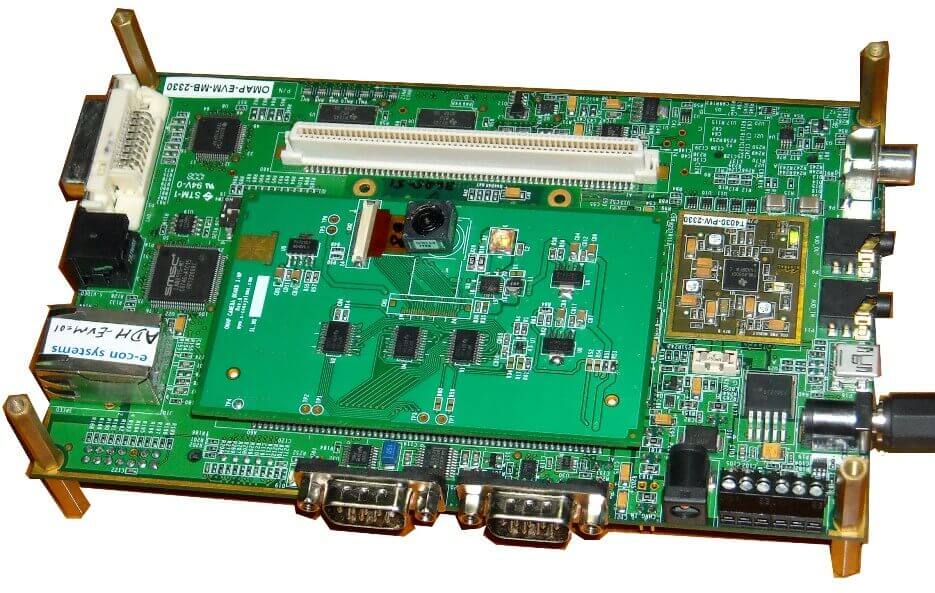Texas instruments has recently announced the OMAP 35x processor series which has taken the market by storm. Many customers are getting interested in it because it supports
- The latest ARM Cortex A8 Superscalar core.
- Supports 2D graphics acceleration using PowerVR SGX OpenGL ES 2.0 compliant graphics accelerator. NEON SIMD Engine with fixed and floating point operations
- Supports DSP instructions – Powerful TMS320C64x DSP Core
- Supports ISP(Image signal processor) for cameras that might be of good use for processors that dont have an ISP inside.
- Input pixel clock of 130Mhz.
The support for ISP inside the camera is useful since when we design handhelds, the mechanicals of the camera modules becomes important. The ISP contains lot of stuff to fine tune the images, do auto focusing etc. The ISP from TI supports Histogram engine that can be used for Autofocus, Autoexposure and Autowhitebalance (3A). Any camera module these days come with a ISP inside and the mechanicals for the handheld are good enough to squeeze the ISP also inside the camera module as a single SOC.
OMAP Camera hardware software EVM kit
At resolutions like 5MP or 8MP, the camera modules that are available commercially do not support a ISP since it would be difficult to put the ISP and the 5MP frame in a small form factor. So, these high resolution camera modules have the ISP outside, at least during the initial pilot production. In fact I have seen some of the initial releases of the new sensors often have only Bayer RGB output that is fed to external ISP. It will be a matter of time when they are able to put the ISP in the same form factor but then market requirements would rise to may be 10MP! The demand for external ISP solutions would continue to exist. So, for those camera modules that don’t have a ISP inside, the TI OMAP processor’s ISP pipeline is very useful. It has got features like color correction, gamma correction, dead pixel correction, Sharpen filter, autofocus engine etc. All these are done through hardware.
Now, you might ask a question on whether this will slow down the processor since all these are inside the processor. Valid point. Since, these processors will be used in embedded systems and considering the typical use cases they are used for, this may not be an issue at all. At least it will be much faster than CPU doing these operations in software. When the image resolution increases, say at 5MP, we are talking about 5Mbytes of Bayer data, 10Mbytes of YUV422 data or 15Mbytes RGB888, which is really huge.
Ok, what does it offer for those camera modules that have a ISP inside it? The OMAP 35x processor has DSP capability and VFP which makes it ideal for image processing applications like name plate capture, digital microscopy, facial detection, pupillometer etc. There are MPEG4 and H.264 codecs that are available for C64X DSP (OMAP3530 has TMS320C64x DSP inside), offering complete encoding solution on a chip, in addition to normal embedded processing capabilities. Also, the OMAP 35x supports a pixel clock of 130Mhz with a 8 bit bus which would mean a bandwidth 1.04Gbps. This is somewhat unmatched by USB 2.0 or any standard that is available so far. Since this ties up with a ISP inside, if you are doing a design based on camera and there is good amount of image processing then IMHO, this is the processor of choice.
We recently announced camera support for TI OMAP 35xx EVM board with Windows CE 6.0 directshow drivers on it. We have supported some of the ISP features also in the driver.






9 comments
Hi,
Do you provide WMV9 encoding through directshow?
Thanks,
Scott
Hi Scott,
The directshow drivers are under development. We will be completing the direct show version by end of this week. Through this, we will be able to do a WMV9 encoding and save it to the local disk. Through this, customers can use the native direct show compatible hardware codecs provided by TI.
Thanks,
Hari
will your Omnivision sensor board work with TI’s DM365?
Yes, the same board should work with DM365 too as it supports the camera interface exposed by the OMAP 3530. However, we have not tested that.
Will this module work with TI’s OMAP3525 ???
Yes, it works with OMAP3503, OMAP3515, OMAP3525 and OMAP3530
Hi,
Do I get video streaming application in binary/source form with this module?
Regards,
Krishna
Hi,
Can You provide linux drivers and examples for the omap-35x-camera ? As for the Gumstix module
Is the omap-35x-camera compatible with revision G of the Mistral OMAP3EVM board.
Kind regards
Hi Morten,
For the e-CAM32_OMAP35x(Camera board for the EVM Board), we have the Linux drivers ready for both 3.2M pixel and 5M pixel(OV5642 based). It definitely works with the Rev D board and the same interface is provided on the Rev G board(we have seen the schematics). We havent tested with the Rev G board yet,but it should work. If you need more information, please write to sales@e-consystems.com.
Thanks,
Hari shankkar
Comments are closed.